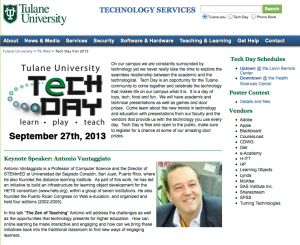The Los Angeles Review of Books just published a debate on the future of the Humanities and the lion’s share was, of course, the idea of MOOC:
I liked the debate very much, and I was impressed by the ideas expressed, like Professor Al Filreis from the University of Pennsylvania, who, after offering a “classic” course on contemporary American poetry, began opening it up until he found himself doing it in an online, sort-of-massive scale and definitively open way. So Filreis does a quasi-MOOC without giving up intelligence to machines and the usual, quintessential humanities discussions, interpretations and illuminations were given the role they deserve in the newest version of his course.
He writes:
ModPo is not a textbook; it’s a course, having about it the sense of a course: a collective movement through material, in which one learns the material with teachers and learners working at roughly the same time. […] The 10-week experience of ModPo happens when it happens, during those 10 weeks, creating a sense that a course is being offered. Many ModPo students have described it, despite its size and despite the far-flung inhabitations of its members, as more “personal” than many huge auditorium-based lecture courses from their university days.
ModPo was, and is, the next step in a 30-year evolution of my course. [My underline]
Filreis has a clear sense that he’s using the highest technology with the utmost sense of personalization, and he’s implementing it.
On the other hand, while not expressing different posititons, Cathy N. Davidson, of Duke University, reminds us that the debate on MOOC’s is wrongly biased from the start since, in the US, higher education suffers from a severe disconnect from reality. She writes:
Let’s start with the numbers. 4.1: That’s the grade point average of a high school student entering the University of California, Irvine this year. 450,000: students on the waiting list for community colleges in California alone. 74%: the percentage of students from the richest quartile of households enrolled at the top 150 colleges in the US.
If you have “to be better than perfect to gain admission to your state university”, she observes”, we’re starting off with the wrong foot. If So, what MOOC discussion are we having, really?
Yet our antiquated educational system rewards a hierarchical form of silo’d, standardized teaching and learning that was designed for the Taylorized Industrial Age. Our over-emphasis on standardized testing undermines the intellectual skills of critical thinking and productive contribution needed to thrive in our interactive Do-It-Yourself era.
The idea is then that MOOCs can play an important role in a more democratic, world-wide education. The point here is that this splendid education offered for free to everyone (difficult to resist) is of course American-centered and American-branded. It seems to me analogous to the old Roman ideal of giving Roman citizenship to all conquered peoples, provided they accepted being Roman.
Thus, I am beginning to feel the idea that this is colonization after all. The xMOOCs may be little nicely painted Troyan Horses with no Cassandras advising the populace.
Says Cathy Davidson:
[…] professors at brick-and-mortar institutions have reason to worry that MOOCs are being hyped by venture capitalists who have no real interest in learning. I share that fear. However, our justifiable worry about the future of the professoriate doesn’t help those students being excluded from higher education today.
True. This is why MOOCs are both good and bad, and actually it’s beginning to make no sense at all to discuss about one or the other. I like these two professors mindsets who, while not necessarily agreeing with the Coursera-style MOOCs are simply stating and advancing the value of massive education through creative, organic uses of new technologies. It is not so much a matter of Humanities, thus. Sure, all disciplines subject to deep discussions and interpretations are best taught by opening up such discussions and interpretations, not necessarily closing them up in a machine-controlled environment made of quizzes and video lectures. But I’d like to pinpoint also that Physics and similar hard science should be taught the exact same way, because in the end, we’re just falling in the trap of producing just some “content” for students to consume. That is not the idea of education, no matter if in the Humanities or Sciences. I don’t wish to enter here the dangerous terrain of the old AI discussion. When AI will produce computing systems capable to hold real, engaging, and humane discussions, we’ll talk. I’m sure it will happen.
In the end, a third panelist (Ian Bogost, Georgia Institute of Technology), writes powerful thoughts:
I am not particularly interested in whether MOOCs are “good” or “bad” educational apparatuses, nor whether individual “positive” examples of the uses of MOOCs can be found to disprove wholesale rejections for the form. Rather, I’m interested in what MOOCs generally speaking do to the educational, technological, cultural, social, and economic landscape: in how they function at large. Individual examples of MOOCs illuminate a part of that picture, but not the whole of it. That whole picture is complex; MOOCs may function on many registers all at once, with interdependencies in-between. But, overall, MOOCs seem to function first and most powerfully as new instruments of fiscal and labor policy, rather than as educational technologies. It’s perhaps time we stopped talking about their value as instruments of learning, and started talking more about what choices they are making on our behalf while we are arguing on the internet about their educational potential.
He makes two very important points which I tend to agree with. First, the justification that MOOCs are needed because of people who are left out of the system for economic reasons, both in the US and outside. Not true, says Bogost, because stats suggest the majority of MOOC students are the usual white privileged males. And many already have completed an undergraduate education. But also, he adds, let’s not forget that the current Coursera-style xMOOCs really follow precisely the same old industrialist model of education which is being criticized. That may exacerbate the problem.
Again, I liked this debate and its positions, even if there’s no trace (as it is happening everywhere in a reconstruction of the past) of Siemens’ work (not even in the references!) with the first connectivist MOOCs since 2008. I most closely agree with Al Filreis, who is doing his work as creatively as possible with the affordances of new media and technologies. If he builds MOOCs in so doing, well, that’s OK. Or, as some say: This Ain’t No Silly MOOC!!













